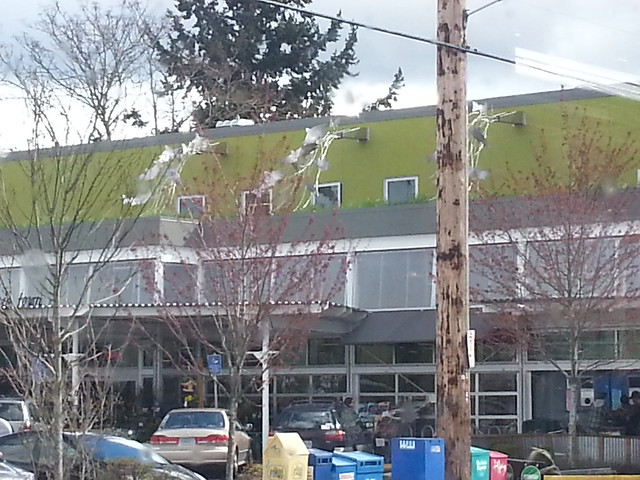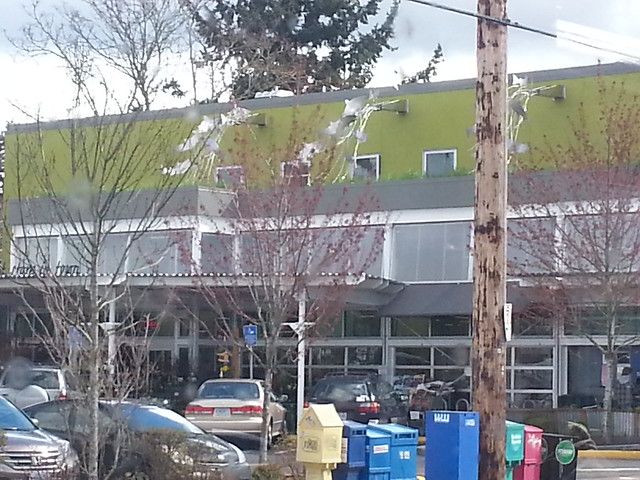View Larger Map
Today's adventure takes us to the intersection at SW Naito & Sheridan, probably one of the uglier places I've ever covered here. At this intersection there's an oddly large, roughly porkchop-shaped traffic island. The city typically landscapes traffic islands this size and makes them sort of park-like (for example, Beryl Triangle, 5th & Caruthers, Regents & Alameda, etc.) This spot, though, is just a vast expanse of drab grey concrete, with a few weeds growing up through the cracks. On top of everything else it's just steps away from the noisy canyon of Interstate 405. It's a great candidate for the godawful ugliest, most brutal-looking, least urban-planned-Portlandia-looking space in the city, or at least within casual walking distance. Which is an actual award I just invented. We aren't here for the scenery, though, as ironic as that would be. And I'm not doing this to grab the top Google result for yet another thing nobody on Earth will ever search for, as rewarding as that always is. Instead we're here for an interesting bit of history that will become clear shortly.
Back in 2008, Portland's annual Pedalpalooza bike festival offered a "Worst of Portland" bike ride, and the ride started right here at Naito & Sheridan. The Portland Mercury described it as "Usually Portlanders can't stop jabbering about how awesome their city is for cyclists. This ride, however, showcases the worst and most dangerous routes. Just watch out for broken glass and 18-wheelers." At least one person survived this adventure, and posted an extensive Flickr photoset of the ride. It looks as though from here they headed across the Ross Island Bridge, then down the ramp onto McLoughlin. Then continued on McLoughlin to Holgate, out to the big railyard, over the Lafayette St. footbridge, and back under the railroad tracks on the ooky pedestrian underpass along Powell, and across the tracks again on the Brooklyn St. footbridge. Then back to McLoughlin and the (now replaced) tumbledown old viaduct near OMSI, and then up to a scramble around the Steel Bridge. That was either where the ride ended, or where the photographer stopped taking photos.
A common thread along that strange journey is that they generally followed busy streets designed in the 1920s thru 1940s, when the world was still learning how to design major roads properly. That era's vision of the high-speed traffic artery of the future did not really include bikes or pedestrians or any other ideas beyond getting from point A to point B as quickly as possible.
So how does this relate to the Naito & Sheridan traffic island? If you look at the overhead shot on the map above, you might notice the grey concrete comes in a few different shades, and you can sort of make out where the traffic flow used to be quite different than it is now. Look for the weedy seam up the middle of the triangle, not quite parallel with Naito. It turns out this was once the southern end of the old Harbor Drive freeway, aka Highway 99W, the 1940s highway that Portland tore out in 1973 to build Waterfront Park (which we're still bragging about, forty years later). At the intersection with Sheridan St, northbound Harbor Drive split off from Naito (then called Front Avenue) and angled downhill to where Riverplace is now, and continued through what's now Waterfront Park up to the Steel Bridge. So this ugly traffic island here is one of the last surviving relics of that long-vanished freeway.
Southbound Harbor Drive traffic actually passed under Front Avenue in a tunnel before merging onto Front at Sheridan. The aforementioned seam marks the edge of where this ramp used to be. For a better idea of what that was like, see this Vintage Portland post with a 1944 photo taken at this very spot, looking north toward the Harbor Drive interchange.
It turns out that the long-abandoned Grant Street Tunnel still exists; it was walled up after Harbor Drive was demolished, but was opened temporarily in 2011-2012 while the Water Bureau ran a new water main through it. If only I'd had the proper connections and known the right strings to pull, I would've loved to put on a hard hat and check it out, take a few photos, write a blog post about it, you know the drill.
The name "Sheridan Triangle" is something I invented just now, by the way I don't usually do that, but I figured it needed a name, and it didn't have one, and this was the obvious candidate. It turns out there are already Sheridan Triangles in Manhattan, Chicago, and Madison, WI, so one might argue that having a place by this name is the mark of a Real City. So, ok, that's kind of a silly argument. In any case, I occasionally think it would be fun to do something with the Sheridan Triangle to brighten it up a little. Maybe paint it, similar to the City Repair street graphics around town. That would be the cheapest option, anyway. A statue or a fountain or something might work here, too, but I'm not sure what it would take to de-uglify the area, short of completely tearing out this stretch of Naito and redoing it, building a cap over I-405, and probably replacing a lot of the buildings nearby. That would be a good start, albeit a very expensive good start.
Anyway, here are a few items from the Oregonian database related to this forgotten and misbegotten spot:

